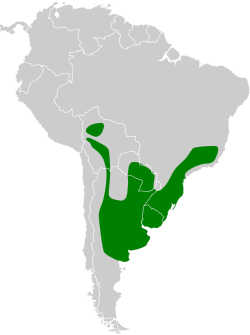Taxonomy and species list
The genus Embernagra was introduced in 1831 by the French naturalist René Lesson with the Pampa finch as the type species. [2] [3] The name combines the names of two genera: Emberiza introduced for the buntings by Carl Linnaeus in 1758 and Tanagra introduced for the tanagers by Linnaeus in 1764. [4]
This genus was traditionally placed with the buntings and New World sparrows in the subfamily Emberizinae within the family Emberizidae. [3] A molecular phylogenetic study published in 2014 found that Embernagra was embedded in the tanager family Thraupidae. Within Thraupidae Embernagra is now placed with Coryphaspiza and Emberizoides in the subfamily Emberizoidinae. [5] [6]
The genus contains two species: [6]
Genus Embernagra – Lesson, 1831 – two species| Common name | Scientific name and subspecies | Range | Size and ecology | IUCN status and estimated population |
|---|
| Serra finch  | Embernagra longicauda
Strickland, 1844 | Brazil
 | Size:
Habitat:
Diet: | LC
|
|---|
| Pampa finch  | Embernagra platensis
(Gmelin, 1789) | Argentina, Bolivia, Brazil, Paraguay, and Uruguay
 | Size:
Habitat:
Diet: | LC
|
|---|
This page is based on this
Wikipedia article Text is available under the
CC BY-SA 4.0 license; additional terms may apply.
Images, videos and audio are available under their respective licenses.



